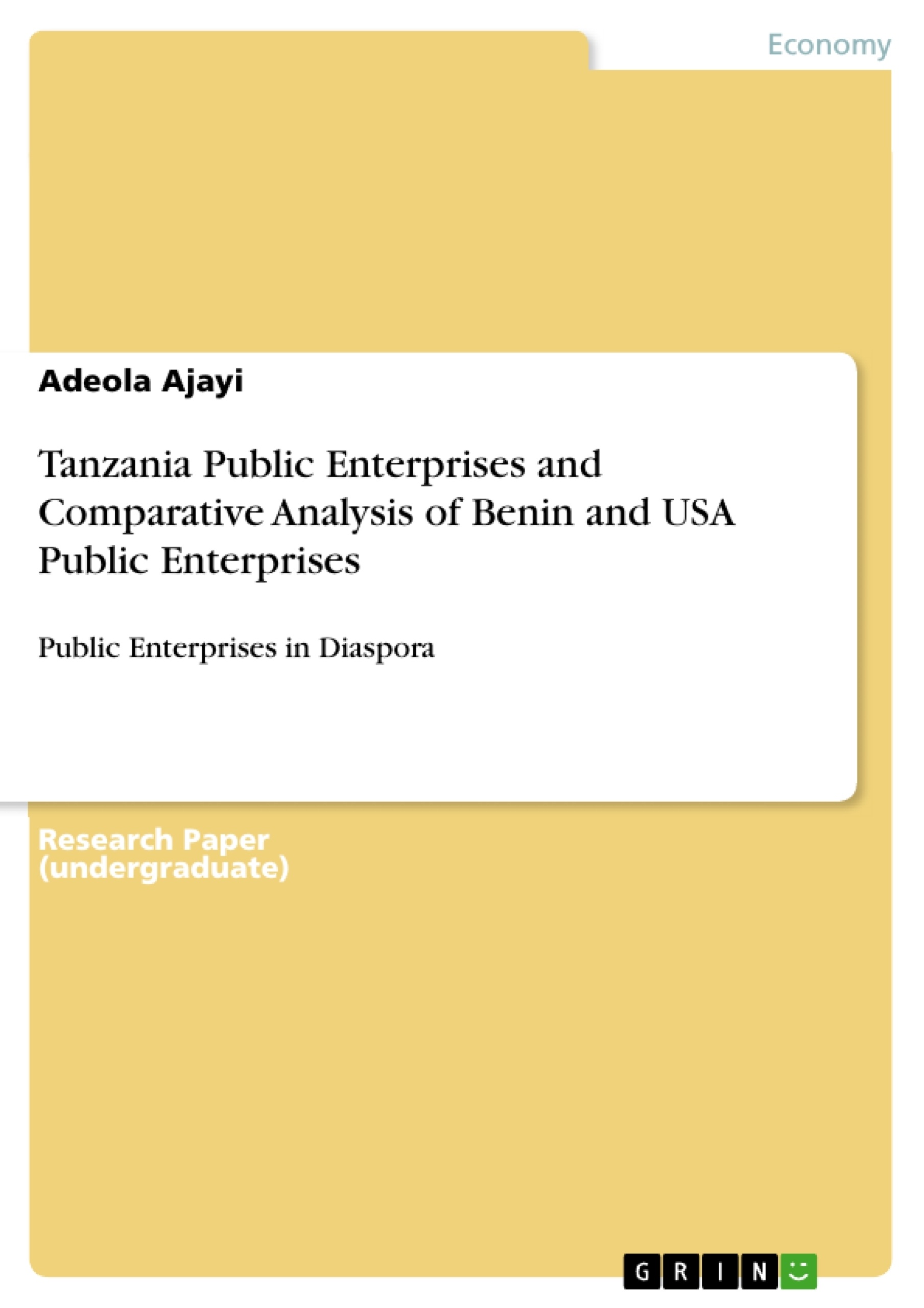The term paper examined the experiences of public enterprises in Tanzania.It also assessed the comparative analysis of public enterprises in USA and Benin Republic.The paper concluded by enumerating the differences between the public enterprises of the two countries.
ABSTRACT
The term paper examined the experiences of Tanzania in the Management of Public Enterprises and also assessed the Comparative Analysis of Benin Republic and USA in the Management of Enterprise.It also enumerared the differences between the public enterprises of the two countries.
MANAGEMENT OF PUBLIC ENRERPRISES IN TANZANIA
Important feature of the public sector in Tanzania is that of public enterprises (parastatals). In the drive for a socialist economy, the country developed a very large parastatal sector. In 1966 there were about forty-three parastatals, primarily in the electricity and mining sectors. By 1988 there were 410 parastatals as a result of the nationalizations of the late 1960s and early 1970s and the basic industrial strategy, which established a number of industrial parastatals. About 70 percent of these are commercial parastatals, which until recentrly played a dominant, often monopolistic, role in many key sectors. In the early 1990s manufacturing parastatals accounted for about 60 percent of total value added in the sector, and they had monopolies in several major segments of the industrial sector – beer, cigarettes, steel, and electric cables. The same was true in the services sector, including the banking industry and the hotel sector, where the state enjoys a dominant position. The parastatal sector accounts for the estimated 25 percent of total wage employment and about 20 percent of GDP. The situation has changed significantly in the 1990s after the launching of a parastatals privatization program and significant new investments by both foreign and local private investors.(Zitto,2009)
The financial performances of the parastatals over the years was no the whole very poor. According to the government auditor of parastatals was about 8 percent of GPD in 1989. By then many parastatals could barely cover salaries. In 1991 only forty-three of 220 commercial parastatals surveyed were able to generate adequate revenue to service debts fully. The chronic loss makers survived by accumulating debts with other parastatal or the government and accumulating arrears payments in such areas as pension fund contributions and taxes. The combined value of these implicit subsidies to parastatals equaled nearly 10 percent of GDP by the time the privatization program was launched in earnest about 1994.
To reform the parastatals sector, the government announced a threefold plan in 1992. Public service organizations that had previously been classified as parastatals would be declassified had incorporated into government departments; public utilities would remain as parastatals but would be subject to performance contracts, and the entry of new service providers would be permitted in selected areas; and all commercial parastatals would be subjected to divestment and privatization. A presidential Parastatals Sector Reform Commission (PSRC) was then established to oversee the reform. Since it was launched in 1992 the PSRC’s performance in the coordination of divestiture of Tanzania’s parastatals sector has recorded considerable progress. Divestiture of 194 parastatals has already been completed; 31 in the Ministry of Natural Resources and Tourism; 64 in Industry and Trade; 26 in Communications, Transport, Housing, Minerals, and Energy; and 73 Agriculture, Education, Information, and Water.
Various means of divesting have been employed, including flotation, which was only feasible after the commencement of operations at the Dares Salaam Stock Exchange in April 1998. In some cases the government managed to divest only partial holdings, and the rest would be sold out later. A majority of the divestitures were carried out through share sale accounting for 24 percent, receivership for 19 percent, and asset sale for 16 percent. (Ndulu, 1997).
A large number of other parastatals are in various stage of preparation for divestiture, with the focus now shifting from the divestiture of small and medium-scale entities in agriculture, industry, and services to larger, high-impact companies in the infrastructural and utility sectors, banking and aviation. The scope of the privatization program has been greatly expanded after the government’s decision in mid-1996 to proceed with the introduction of private sector participation in the infrastructure and utility parastatals, namely, power, water, railways, port, and airlines, and the inclusion of the National Bank of Commerce (NBC) under the PSRC’s divestiture mandate. By the end of the current five-year tenure (December 19987), a little more than half (230) of the 395 parastatals earmarked for divestiture will have been divested. The rest will be proceed during the expected second phrase of the PSRC’s tenure, to end by the year 2000. (Mbowe,2009)
[...]
- Quote paper
- Adeola Ajayi (Author), 2010, Tanzania Public Enterprises and Comparative Analysis of Benin and USA Public Enterprises, Munich, GRIN Verlag, https://www.grin.com/document/197844
-

-

-

-
Upload your own papers! Earn money and win an iPhone X. -

-
Upload your own papers! Earn money and win an iPhone X. -

-
Upload your own papers! Earn money and win an iPhone X. -

-
Upload your own papers! Earn money and win an iPhone X. -

-
Upload your own papers! Earn money and win an iPhone X.

